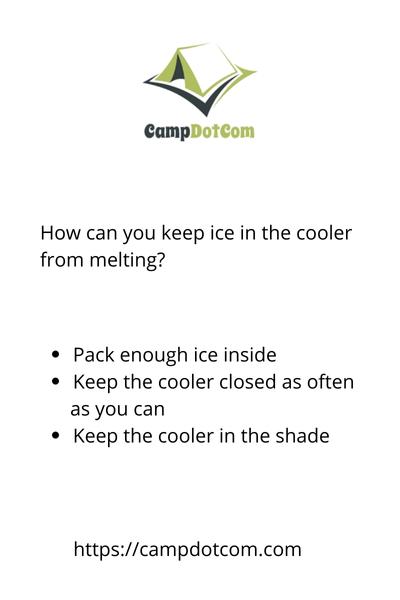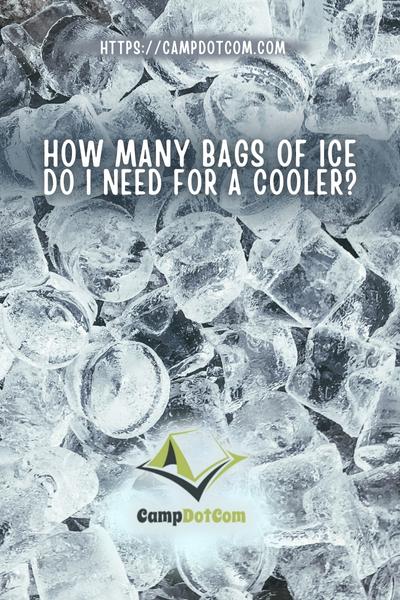It's summertime, and that means time spent outdoors with family and friends. A cooler is a must-have for any outdoor activity, whether you're headed to the beach, park, or campground.
But how much ice do you need to pack in your cooler to keep everything cold? Here is a guide to help you choose the right amount.
Read More About How Many Bags of Ice Do I Need for a Cooler
As an Amazon Associate, I earn from qualifying purchases. Some of the links in this article are affiliate links. This means that, at zero cost to you, I will earn an affiliate commission if you click through the link and finalize a purchase.

More Things To Know About How Many Bags of Ice Do I Need for a Cooler

When planning an outdoor adventure or a simple picnic, figuring out how many bags of ice you need for your cooler can be a bit of a puzzle.
Striking the right balance between ice and the items you're keeping cool is essential for ensuring your food and drinks stay at the perfect temperature.
We'll help you determine the ideal ice-to-cooler ratio, explore different cooler and ice types, and share some tips for keeping your ice from melting too quickly. Let's dive in!
What Are The Factors Affecting Ice Quantity?
Before you can determine how many bags of ice you'll need for your cooler, it's important to consider a few key factors. These include the size of your cooler, the duration of your trip, and the type of items you're storing.
The longer your trip, the larger your cooler, and the more perishable items you're packing, the more ice you'll generally need.
What Are Cooler Types and Their Ice Retention Capabilities?
Not all coolers are created equal. Here's a quick rundown of the most common cooler types and their ice retention capabilities:
Regular coolers
These are your everyday, affordable coolers. While they can keep your items cool, their insulation is less efficient than that of high-performance coolers, so you'll need more ice to maintain low temperatures.
These are highly-affordable but won't work nearly as well as a high-performance cooler. The most popular and well-known name for camping gear is Coleman and the Coleman Chiller Series is perfect for a day at the beach or your favorite park.
- ICE RETENTION: TempLock insulation keeps drinks ice cold
- PORTABLE: 2-way handles swing up to make it easy to lift, and fold down and out of the way
- MORE HEIGHT: Fits 2-liter bottles upright to prevent spills
As an Amazon Associate, I earn from qualifying purchases
High-Performance Coolers
Designed for extended trips and heavy-duty use, high-performance coolers boast thicker insulation and more robust seals. This means they can retain ice for longer periods, requiring less ice overall.
A high-performance cooler would be something like the YETI Tundra cooler.
- The YETI Tundra 45 combines versatility with durability with a capacity of up to 26 cans with a...
- Ice stays ice thanks to up to 3 inches of PermaFrost Insulation and an extra thick FatWall...
- The Rotomolded Construction makes the Tundra armored to the core and virtually indestructible...
As an Amazon Associate, I earn from qualifying purchases
Soft Coolers
Lightweight and portable, soft coolers are ideal for short trips and small loads. However, their insulation isn't as effective as hard-shell coolers, so they need more frequent ice replacement. Although, they have improved tremendously over the last few years. One of the best soft coolers is the ROCKBROS Soft Cooler.
- ✔SUPER PERFORMANCE OF COLD HOLDING: ROCK BROS leak proof soft cooler designed with 3 special...
- ✔100% LEAK PROOF & WATERPROOF GUARANTEE: Insulated leak proof soft coolers use the airtight...
- ✔22L SUPER LARGE CAPACITY: Leak-proof soft sided cooler has a large capacity you never seen...
As an Amazon Associate, I earn from qualifying purchases
What Are The Different Ice Types?
Ice comes in various forms, each with its own advantages and drawbacks. Here are the most common types of ice you'll encounter:
Crushed Ice or Cubed Ice
With its high surface area, crushed ice cools items quickly but melts faster than other ice types.
Ice Blocks
These large, solid blocks of ice melt slowly, providing long-lasting cooling. However, they take up more space and don't conform to the shape of your items as easily as crushed ice.
Ice Packs
Reusable and mess-free, ice packs can be a convenient option. But they don't always provide the same cooling power as traditional ice.
How Long Does Ice Last in a Cooler?
The longevity of ice in a cooler depends on factors like the cooler's insulation, the ice type, and the surrounding temperature.
In general, ice lasts longer in high-performance coolers and when using ice blocks or packs. Regular coolers with crushed ice may require more frequent ice replacement, especially in hot weather.
How to Keep Ice from Melting in the Cooler?
Maximize your ice retention with these handy tips:
- Pre-chilling the cooler: Store your cooler in a cool place and fill it with ice or ice packs a few hours before packing to lower its internal temperature.
- Using a combination of ice types: Combine crushed ice and ice blocks or packs to benefit from both rapid cooling and extended ice retention.
- Properly packing the cooler: Place ice at the bottom, followed by heavier, less perishable items. Add more ice, and then place lighter, more perishable items on top. Fill gaps with additional ice or ice packs.
- Limiting air exposure: Open your cooler as infrequently and briefly as possible to minimize warm air from entering and melting the ice.
How To Calculate The Ideal Ice-to-Contents Ratio?
A general rule of thumb is to aim for a 2:1 ice-to-contents ratio, meaning two parts ice for every one part of food and drinks.
However, this ratio can vary depending on the factors we've discussed, such as cooler type, ice type, and trip duration. Remember to adjust the ratio based on your specific needs and circumstances.
How Many Bags of Ice Do You Need for a Cooler?
Now that you have a better understanding of the factors that influence the ideal ice-to-cooler ratio, you can confidently prepare for your next outdoor adventure.
By choosing the right cooler and ice types and following our ice retention tips, you'll ensure your food and beverages stay fresh and cold throughout your trip. So, gather your gear, pack your cooler wisely, and get ready to embark on your next chilling adventure!
Remember, the key points to consider when determining how many bags of ice you need for your cooler are the size of the cooler, the type of cooler, the type of ice, and the duration of your trip.
By evaluating these factors, you'll be able to make a more informed decision and enjoy a worry-free outdoor experience.
Don't forget that you can always experiment with different ice-to-contents ratios and ice types to find the best combination for your specific needs.
And, most importantly, don't be afraid to ask for advice from fellow adventurers or search online for more tips and tricks. There's a wealth of knowledge out there just waiting to be discovered.
So, what are you waiting for? Start planning your next outdoor adventure, and let your cooler be your trusty companion. Happy trails!
FAQs
Here are some frequently asked questions related to ice, coolers, and ice retention:
Can I use dry ice in my cooler?
Yes, but only in well-ventilated areas and with coolers designed to accommodate it. Dry ice is much colder than regular ice and can cause burns if touched directly. It also releases carbon dioxide gas as it sublimates, which can be dangerous in confined spaces.
How can I dispose of melted ice water in an environmentally friendly way?
Melted ice water can be poured onto plants, grass, or soil away from water sources to prevent soil erosion and minimize the impact on local ecosystems.
Is it safe to eat food that has been in contact with melted ice water?
As long as the water is clean and the food is still cold to the touch, it should be safe to eat. However, it's best to avoid consuming food that has been submerged in melted ice water for extended periods or shows signs of spoilage.
How can I clean my cooler after using it?
Empty the cooler, wipe it down with a mild detergent and warm water, and rinse thoroughly. Allow it to air dry with the lid open to prevent mold and odors.
Can I use frozen water bottles as an alternative to ice packs?
Yes, frozen water bottles can serve as a reusable and mess-free ice substitute. They may not provide the same cooling power as ice packs, but they're a convenient and cost-effective option.



